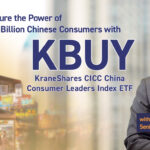Spirits, Fashion, Food, Appliances, and the Power of China’s Consumer
In this video, KraneShares cultural analyst Xiabing Su takes us on the ground in China to explore key industries and companies offering exposure to the rise of China’s domestic consumption, and CIO Brendan Ahern introduces the KraneShares CICC China Consumer Leaders Index ETF (ticker: KBUY).
Contents
- China's top spirits brand is the world's largest beverage company by market cap, but we couldn't find any when we visited a 5-star hotel bar in China.
- One Chef claims Haitian sauce, an indispensable component of Chinese kitchens, is the secret ingredient in his Stir Fry King Oyster Mushroom with Beef.
- Demand for sausage in China is so strong that Chinese food processor, Shuanghui, bought Smithfield Foods, the largest pork processor in the US, in 2013.
- China's fast-growing home appliance market and how Mainland's "home appliance queen" sold billions worth of refrigerators on TikTok.
- Why "Guochao" or fashion and design that highlights Chinese cultural elements, has pushed a new generation's preference toward domestic brands.
Introduction
Hello, I’m Xiabing from KraneShares. Today I’m going to discuss some of the unique opportunities from China’s growing domestic consumption. I also checked in with our Chief Investment Officer, Brendan, to get an overview of our new fund: The KraneShares CICC China Consumer Leaders ETF (ticker: KBUY).
Brendan Ahern
The KBUY portfolio provides extensive exposure to a wide range of brands including home appliances, alcohol and liquor, and food and apparel. Many investors are surprised to learn that China’s retail sales surpassed that of the United States in 2019 when China clocked 5.8 trillion dollars worth-of-good sold versus 5.5 trillion dollars here in the United States1. Even with the world's largest middle-class population, China still has immense potential for further consumption growth. Recent advancements in E-Commerce platform technologies and discounted group buying programs have helped domestic brands expand their reach to lower-tier cities.
We are also seeing how rising incomes in China have contributed to an overall consumption upgrade, consisting of a stronger preference for high-quality products, brand loyalty, and more luxury spending. New technology infrastructure, such as mobile payments, big data, artificial intelligence (AI), and cloud computing, is significantly enhancing the shopping experience, making it much more convenient and efficient as well as enabling companies to reach much larger audiences. Many of the brands and companies that we hold within KBUY might not be familiar to those outside of China. For a further examination of these companies, I‘m going to hand things off to my colleague Xiabing Su.
Moutai
The new year is around the corner, and Kweichow Moutai has become one of the most prestigious and wanted gifts in China. Kweichow Moutai earns its name as the spirit of China because of its extraordinary taste. It is the only alcoholic beverage presented as an official gift by Chinese embassies in foreign countries. In 1972, Chinese premier Zhou Enlai used the liquor to entertain U.S. President Richard Nixon during the state banquet for his presidential visit to China. In 1974, the US Secretary of State Henry Kissinger told Deng Xiaoping, China's future leader that "I think if we drink enough Moutai, we can solve anything."
Kweichow Moutai has been a symbol of Chinese culture, and also a display of status and wealth because of its limited supply. The price of Moutai stays at an all-time high2. People also buy Moutai as a kind of investment, looking for an increase in value. Kweichow Moutai’s company value has reached 402 billion dollars, followed by another Chinese liquor brand, Wuliangye, with a valuation of 176 billion dollars3. To better understand the liquor market, I went to a 5-star hotel restaurant for a visit. However, I didn’t see Moutai on their liquor shelf, which really surprised me.
Xiabing: Hello miss, I didn't find Moutai on the liquor shelf, do you sell Moutai here?
Bartender: Hello, we do sell Moutai here, but it is in short supply now. We sell as many as we have, and there is no inventory these days.
Xiabing: Okay, turns out Moutai is a hot item!
Bartender: Yes, it's a luxury brand just like Hermes.
Xiabing: How much is a bottle of Moutai now?
Bartender: Now the price is getting higher and higher. The wholesale price is 1,499 yuan (~232 dollars), but now the retail price is over 4,000 yuan (~620 dollars).
Xiabing: So expensive! The price didn't seem to be so high a few years ago!
Bartender: It's really hard to buy a bottle. Moutai is not something you can just buy with money. Many customers buy Moutai for collection, (or) they make appointments in advance.
Xiabing: What about Wuliangye?
Bartender: We have Wuliangye in stock. If you can't buy Moutai, the next best option is Wuliangye. They are both good liquor brands in China, ranked No. 1 and No. 2.
Xiabing: Haha, thank you so much.
Wuliangye
On the first day of 2021, I was very lucky to drink the alcohol ranking No. 2 in China – Wuliangye. The taste was so powerful that I can’t forget it…
Kweichow Moutai & Wuliangye rank highest among liquor brands globally in terms of market cap. Combined, these two brands are worth more than the next six leading liquor brands collectively. Also, Kweichow Moutai ranks highest among beverage brands globally in terms of market cap, recently surpassing Coca-Cola this past April4.
Haitian Flavoring
In terms of food culture as a part of a tradition, different flavors were created many generations ago and the recipes often remain as family secrets. Soy sauce and oyster sauce are two of the key flavors, and they have become an indispensable component when used for cooking Chinese dishes or simply as condiments. The Global Soy Sauce Market size is projected to reach $59.13 billion by 2025, increasing at a CAGR (compound annual growth rate) of 5.9% between 2019-2025, according to the KBV Research Global Soy Sauce Market Report. Haitian, the top brand of flavoring, is used by almost all Chinese families and restaurants. I talked to a chef at a local restaurant to provide more color on the company.
Chef: Hello everyone, this dish is Stir Fry King Oyster Mushroom with Beef. I have used several kinds of flavors, and one of them is Haitian Soy sauce. Haitian Soy Sauce is a China time-honored brand. It is widely used by restaurants and families. The biggest feature of Haitian Oyster Sauce is that it is known for its very fresh taste.
Haitian is also one of the essential suppliers for supermarkets, with around 300 different product categories including 4-star products. The company has generated revenues of more than RMB 1 billion (~155 million dollars)5.
Shuanghui
This is what happens every morning. Sausage, as a kind of food condiment, is very popular among Chinese people. One of the most famous brands in China is Shuanghui. I knew this brand when I was a kid because it has always been my mom’s first choice. In 2013, Shuanghui bought Smithfield Foods, the largest U.S. pork processor with 7.1 billion dollars6. Apart from the taste, the meat of Shuanghui is also known for its quality and reliability. Even during the pandemic in the first half of 2020 in China, the revenue of Shuanghui has reached 36 billion yuan (~5 billion dollars), with an increase of 42% over the same period from last year7.
Haier and Gree
In terms of refrigerators and other electric appliances, which are used in everybody's home, Haier and Gree are the most universal choices because they have a high reputation and large market share. China’s home appliance market is posting the highest growth rate globally and is projected to reach more than $130B by the end of 20268. China’s three largest appliance manufacturers – Midea Group, Gree Electric Appliances, and Haier Smart Home – account for roughly 80% of the combined value of China’s top 10 appliance manufacturers.
Even so, these home appliance companies are still expanding their sale channels. Taking advantage of internet shopping and live-streaming, Dong Mingzhu, chairwoman of Gree Electric, also known as Mainland’s “home appliance queen” started her own live stream to sell Gree products via different platforms like TikTok, JD, and Kuaishou. The cumulative sales of her five live broadcasts have exceeded 178 billion yuan (~27 billion dollars)9. It also showed the consumption power of Chinese people.
Li-Ning and Anta
Apart from things to eat and use, things to wear is another essential dimension in people’s lives. People’s choices have gradually shifted to Chinese domestic brands because they offer lower prices without compromising quality as they can work directly with local manufacturers. Also, “Guochao”, meaning fashion and design that incorporates Chinese cultural elements, has become extremely hot among Chinese young people. Two of the most popular “Guozhao” brands are Li-Ning and Anta. Both of the companies started from sportswear, and they innovated themselves both internally and externally. In 2019, Anta achieved revenue of 34 billion yuan (~5 billion dollars), a 30% increase from the last year10. In the first half of 2020, the revenue of China’s Off-White, Li-Ning, reached 6 billion yuan (~942 million dollars), with a 21% increase in net profit11.
Conclusion
The purchasing power of China’s population of 1.4 billion people is simply tremendous. We believe that that purchasing power provides a strong investment case for owning the companies whose products are being purchased by China’s population. Our thesis led to the development and listing of the KraneShares CICC China Consumer Leaders ETF (ticker: KBUY). We very much appreciated the opportunity to introduce KBUY and its underlying portfolio of companies to you. For further information, please visit kraneshares.com.
Citations
- National Bureau of Statistics in China, “Total Retail Sales of Consumer Goods Went up by 8.0 percent in 2019” 2020/01/19.
- Sina Finance, “Why the price of Moutai keeps going up", 2020/09/28.
- Data from Bloomberg, as of 2021/ 01/22.
- Data from CompaniesMarketCap.com as of 2021/01/22.
- Data from grandviewresearch.com, as of 2020/09/30.
- Los Angeles Times, "Pork firm Smithfield sold to China’s Shuanghui for $7.1 billion" 2013/05/29.
- Data from Sohu, as of 2020/08/12.
- Data from Yahoo Finance, "China Home Appliances Market Report 2020: Comprehensive Analysis of COVID-19 on the $130 Billion Market - Forecast to 2026".
- Data from Sina Finance, as of 2020/06/20.
- Data from Xinhuanet.com, as of 2020/03/26.
- Data from ecosports.cn, as of 2020/08/24.
KBUY Holdings Mentioned
- KWEICHOW MOUTAI CO LTD-A, 10.71% of KBUY Net Assets as of 2020/12/31
- GREE ELECTRIC-A, 6.74% of KBUY Net Assets as of 2020/12/31
- WULIANGYE YIBIN CO LTD-A, 5.22% of KBUY Net Assets as of 2020/12/31
- FOSHAN HAITIAN-A, 5.03% of KBUY Net Assets as of 2020/12/31
- HENAN SHUAN-A, 4,96% of KBUY Net Assets as of 2020/12/31
- ANTA SPORTS PRODUCTS LTD,4.68% of KBUY Net Assets as of 2020/12/31
- LI NING CO LTD, 3.79% of KBUY Net Assets as of 2020/12/31
- HAIER GROUP, 3.76% of KBUY Net Assets as of 2020/12/31.
Holdings are subject to change.















